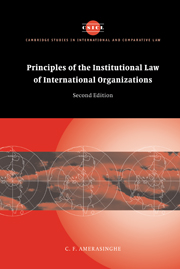Book contents
- Frontmatter
- Contents
- Preface
- List of abbreviations
- Table of cases
- 1 Introduction
- 2 Interpretation of texts
- 3 Legal personality
- 4 Membership and representation
- 5 Non-Judicial organs of organizations
- 6 Acts of non-judicial organs: their legal effect
- 7 Acts of non-judicial organs: the doctrine of ultra vires
- 8 Judicial organs
- 9 The internal law: employment relations
- 10 Privileges and immunities
- 11 Financing
- 12 Responsibility to and of international organizations
- 13 The liability of member states vis-à-vis third parties
- 14 Amendment of constitutions
- 15 Dissolution and succession
- 16 The settlement of disputes
- Index
- Cambridge Studies in International and Comparative Law
9 - The internal law: employment relations
Published online by Cambridge University Press: 10 December 2009
- Frontmatter
- Contents
- Preface
- List of abbreviations
- Table of cases
- 1 Introduction
- 2 Interpretation of texts
- 3 Legal personality
- 4 Membership and representation
- 5 Non-Judicial organs of organizations
- 6 Acts of non-judicial organs: their legal effect
- 7 Acts of non-judicial organs: the doctrine of ultra vires
- 8 Judicial organs
- 9 The internal law: employment relations
- 10 Privileges and immunities
- 11 Financing
- 12 Responsibility to and of international organizations
- 13 The liability of member states vis-à-vis third parties
- 14 Amendment of constitutions
- 15 Dissolution and succession
- 16 The settlement of disputes
- Index
- Cambridge Studies in International and Comparative Law
Summary
It was not till after the Second World War that the internal legal order of international organizations received special attention, particularly in terms of theory. Prior to that international law was essentially perceived as intended to regulate relations between states. This is understandable because the international organizations prior to the Second World War, excluding perhaps the LN, possessed only limited powers and limited autonomy and did not have the importance in international life that they have since acquired. After the Second World War the situation changed with the establishment of the UN and several open international organizations.
The internal law
Principally, the problems arising from the existence of an international civil service have resulted in a practice of recognizing the existence of an internal law of international organizations. They have also led many writers to accept the existence of such an internal law. If the national law of the member states applied to relations between the organization and its staff, the courts of states would probably be competent to hear disputes, apart from employment relations being subject to the laws of member states, a situation which would have had drawbacks for the organization. It would then find itself subject to the control of members. Soon after the creation of the UN the view was expressed that there was no valid reason why an organization should be subject to the law of the state in which its headquarters was located, especially since its staff was of widely different nationalities.
- Type
- Chapter
- Information
- Publisher: Cambridge University PressPrint publication year: 2005



